PsychNewsDaily Publishers
100 Summit Drive
Burlington, MA, 01803
Telephone: (320) 349-2484
PsychNewsDaily Publishers
100 Summit Drive
Burlington, MA, 01803
Telephone: (320) 349-2484
Living with a cat requires home preparation to prevent accidents. Secure cords, block hazardous areas, and provide safe outlets for climbing and scratching to ensure safety.

Living with a cat means you’re sharing your space with a tiny explorer. Every corner is fair game for their next adventure.
From chewing on cords to knocking over plants, little cat habits can turn into big headaches if you don’t prep your home. Cat-proofing protects both your stuff and your cat from accidents you might not see coming.
Just a few smart tweaks can make your place feel calmer and safer for you and your cat. Try things like securing cords, blocking off risky spots, and giving your cat fun alternatives for scratching and climbing.
These tricks help you avoid stress and let your cat explore without getting into trouble.
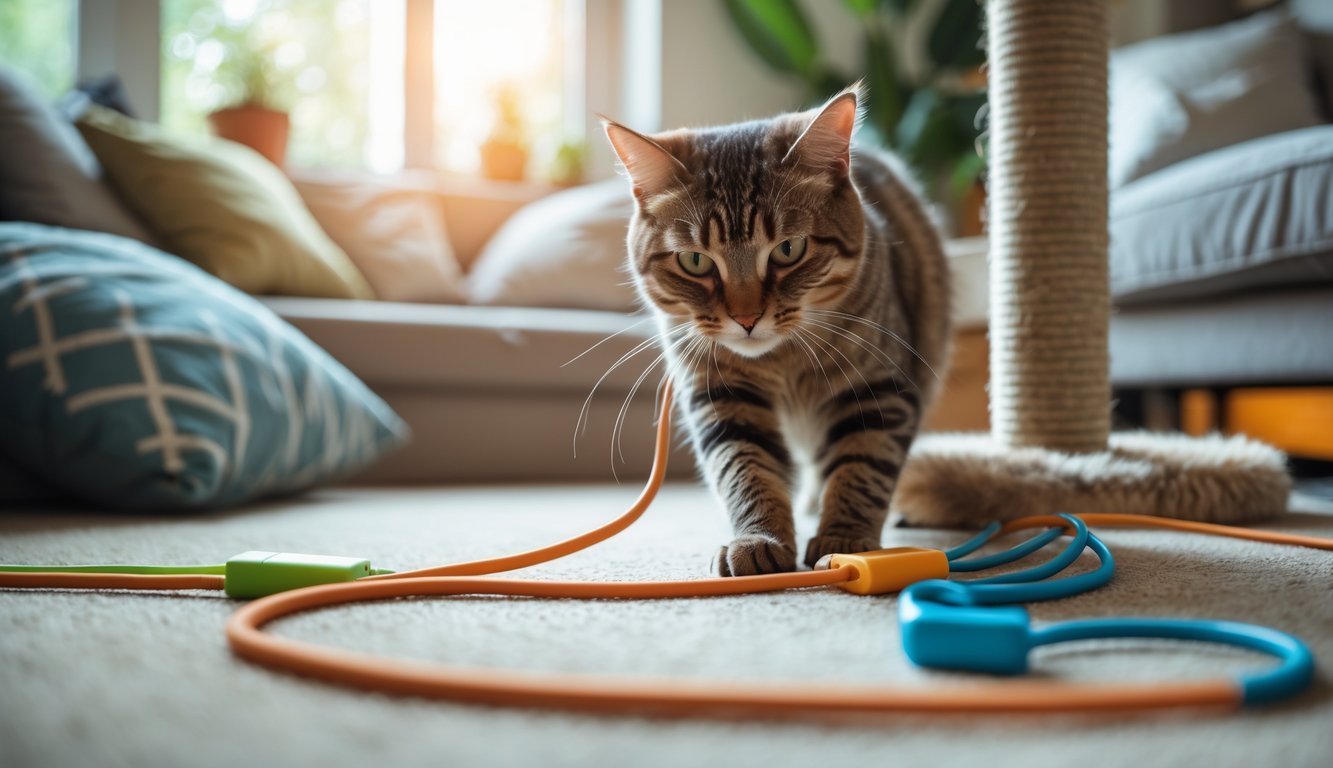
Dangling cords look like toys to cats. When they chew, it’s not just annoying—it’s dangerous if they bite through a wire.
Cover cords with protectors made for pets, like Chewsafe® or PetCords. Some even taste bitter, which really turns cats off.
Cord covers also tidy up your space by hiding messy cables. You can run them along walls, floors, or behind furniture to keep everything out of sight.
If your cat just won’t quit chewing, move wires off the floor or block access to outlets. A mix of these steps keeps your home and your cat safe.
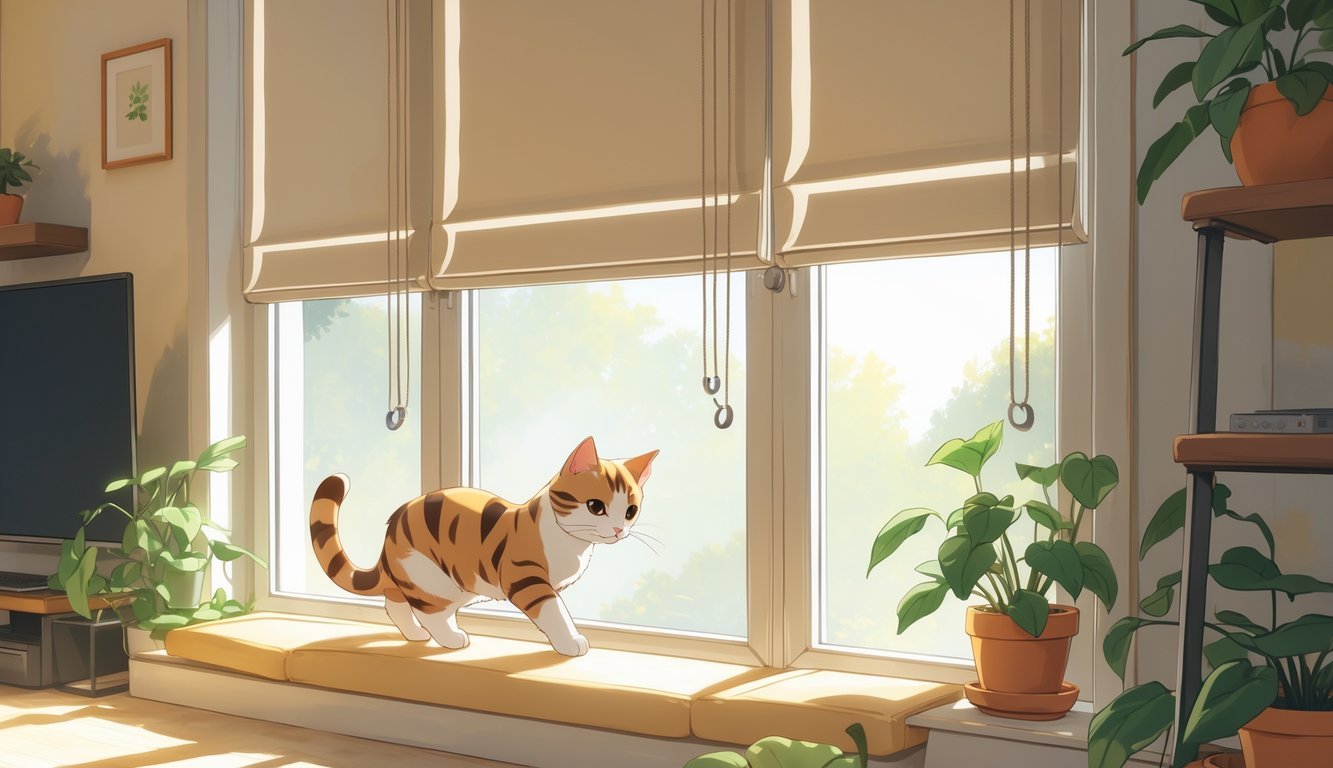
Cats love to climb and swat at anything that dangles. Blind cords? They’re irresistible, but also risky.
Switching to cordless window coverings removes the temptation altogether. They’re also safer for kids, since cords can be a strangulation hazard.
If swapping every window covering at once feels like too much, just start with the rooms your cat hangs out in most. Affordable cordless options are everywhere these days.
Can’t go fully cordless? Pick coverings with hidden or hard-to-reach cords. This way, your windows look neat and you cut down on hazards.

Some houseplants, like lilies and philodendrons, can seriously harm your cat if chewed. Even a nibble can upset their stomach or worse.
Move toxic plants onto high shelves, in hanging planters, or into rooms your cat can’t enter. That way, they’re less likely to nibble leaves or knock over pots.
You could also just swap out risky plants for cat-safe ones. Spider plants, areca palms, and Boston ferns bring in greenery without the worry.
If you love indoor gardening, double-check every plant before you buy. It only takes a minute and can spare you a lot of stress.
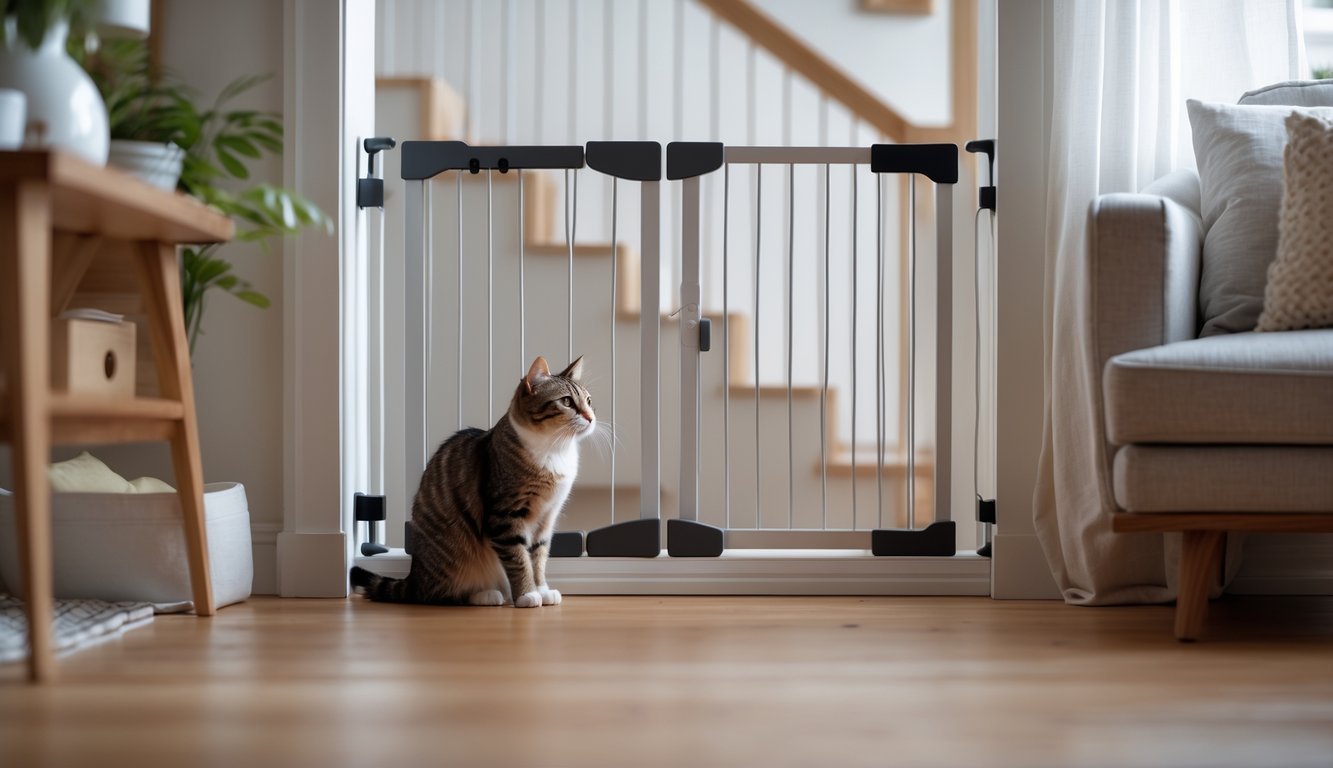
Baby gates or pet barriers help you block off rooms that aren’t safe for your cat. Kitchens, stairs, and laundry rooms often hide dangers like cleaning supplies or hot appliances.
Cats will try to squeeze into tight spots or leap onto counters. A sturdy barrier keeps them out of places where they could get hurt.
If you have both cats and dogs, a gate can keep their food and litter separate. Some gates even have small doors just for cats.
Pick a gate that fits snugly in your doorway or hallway. Pressure-mounted ones are easy to move, while hardware-mounted gates stay put for the long haul.
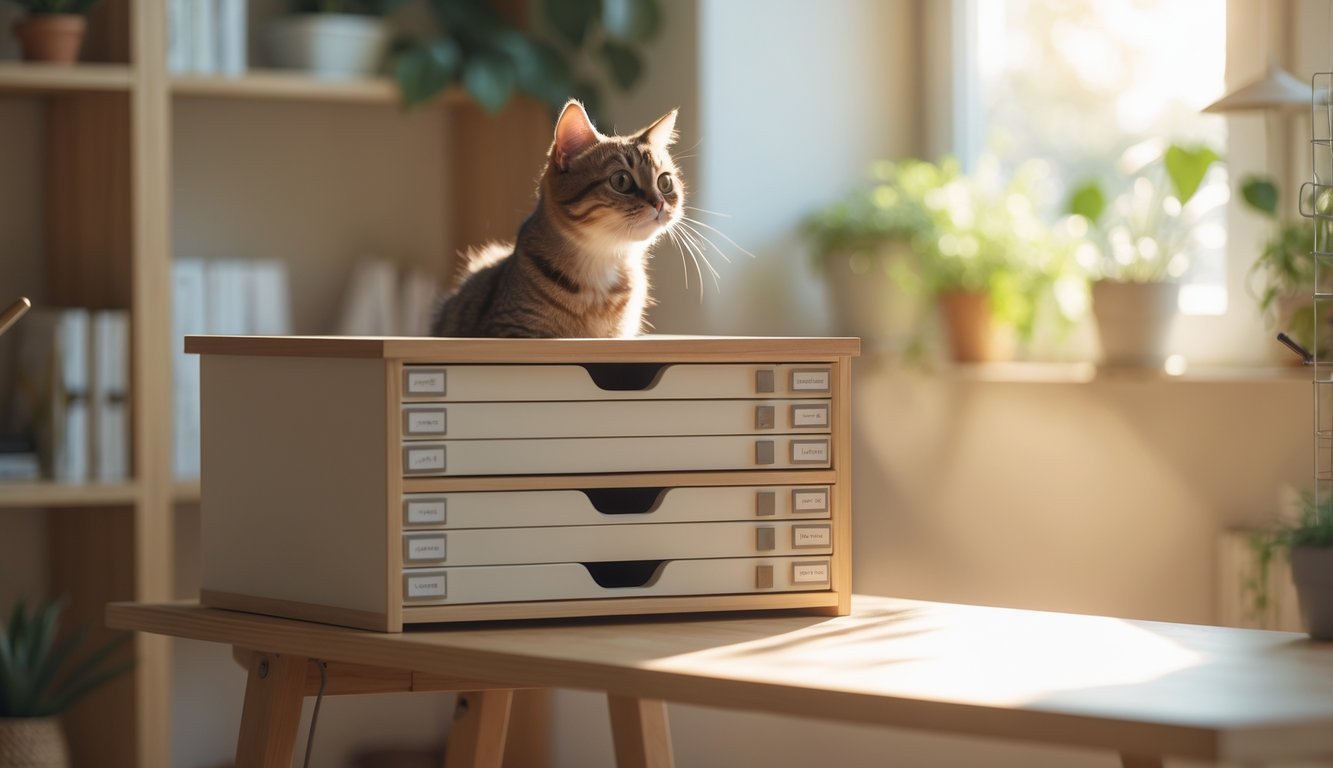
Cats can’t resist batting around small things, but those can be dangerous if swallowed. Rubber bands and paper clips might look like toys, but they’re choking hazards.
Keep these items in closed drawers or containers with lids. It keeps your supplies organized and your cat safe.
Use dividers or trays inside drawers to make it easier to find what you need. You’ll spend less time searching and your cat won’t steal anything risky.
Try to put things away right after you use them. Leaving them out is just an invitation for your cat to play.
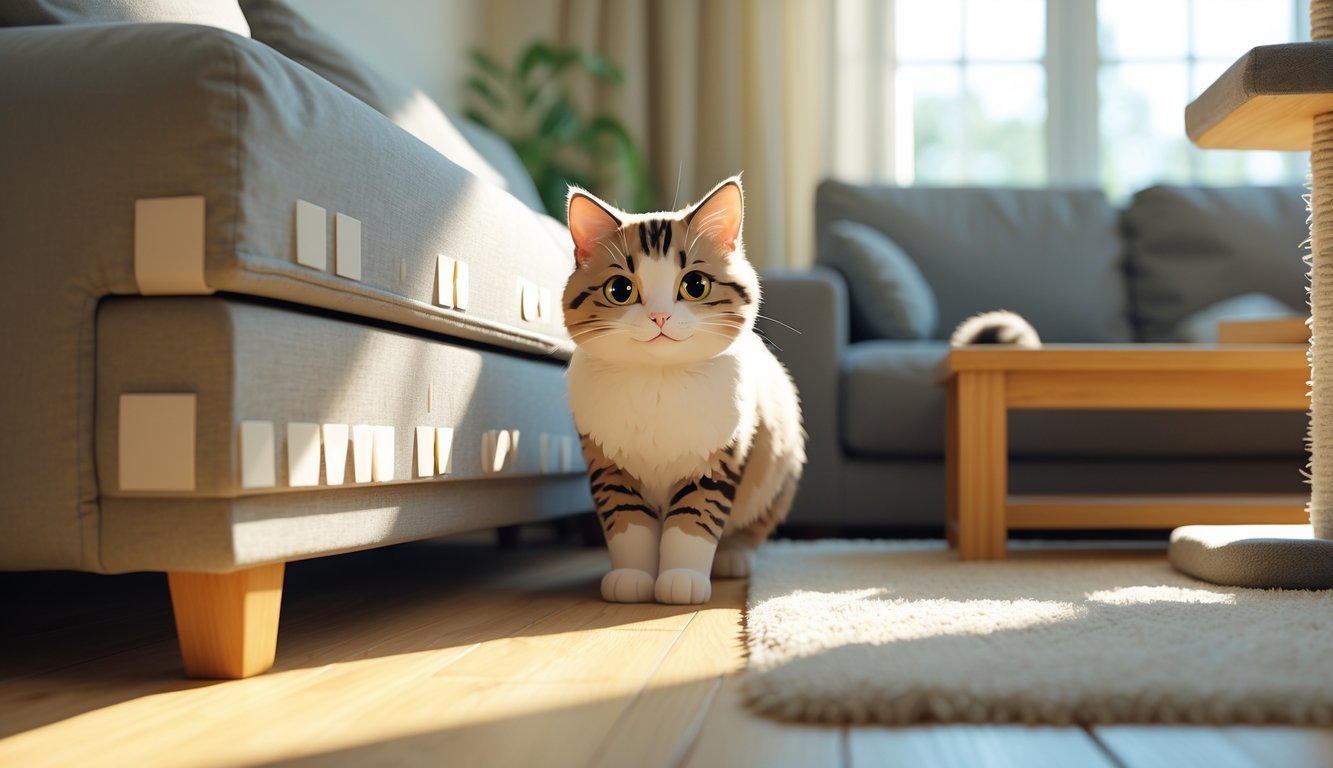
Sticky tape on furniture edges feels weird to cats, so they avoid scratching there. Just a few strips on couch arms or chair legs can make a big difference.
Choose tape made for pets to avoid damaging your furniture. Most are safe for both fabric and wood.
It helps to put a scratching post nearby. That way, your cat learns where it’s okay to scratch.
Once your cat stops targeting the taped areas, you can take the tape off. No need for a permanent fix if the habit is gone.
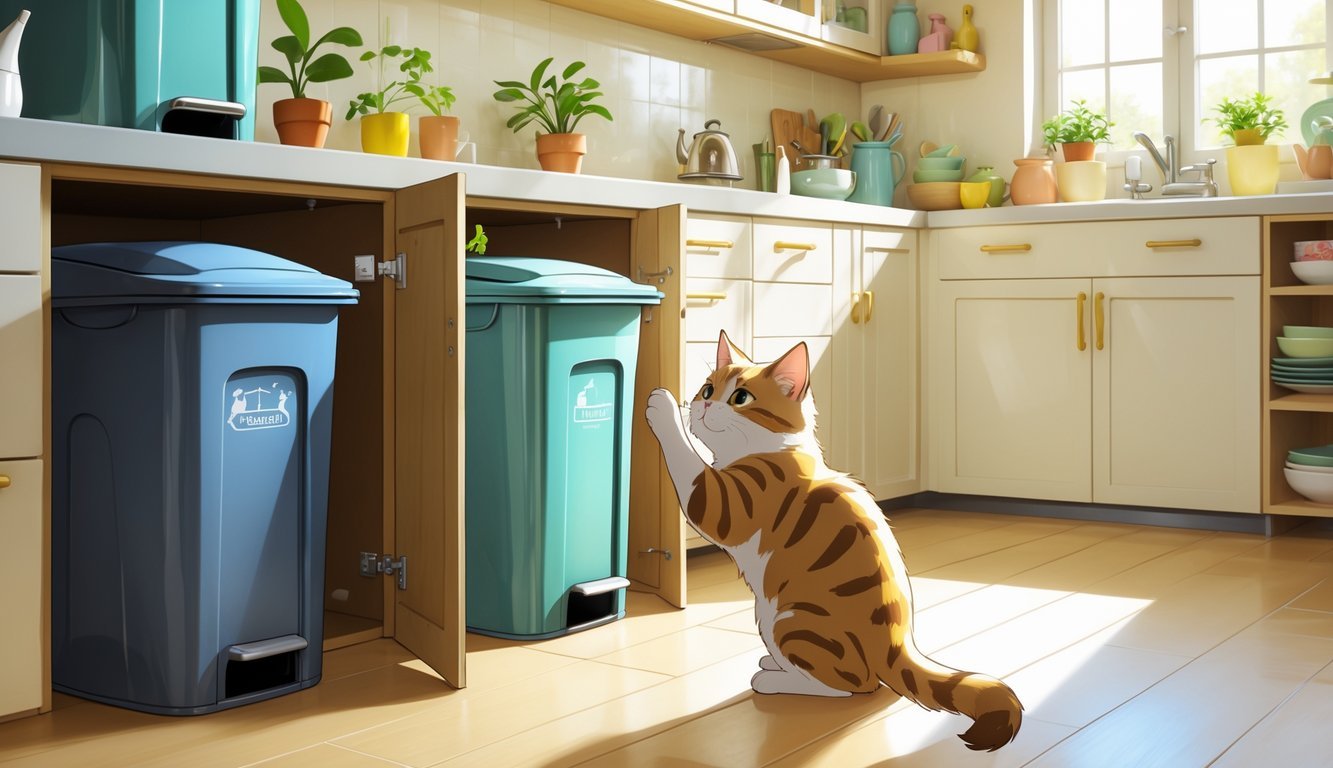
Cats love to poke around anything that smells interesting. An open trash can is just asking for trouble.
A lid does the trick for most indoor bins. If you want extra security, stash the trash can inside a cabinet—under the sink works well.
Some cabinets have pull-out drawers for bins, making them easy to use and keeping everything hidden.
For outdoor cans, a small shed or fence keeps curious cats and raccoons out. Keeping lids closed or bins tucked away stops your cat from turning the trash into a playground.
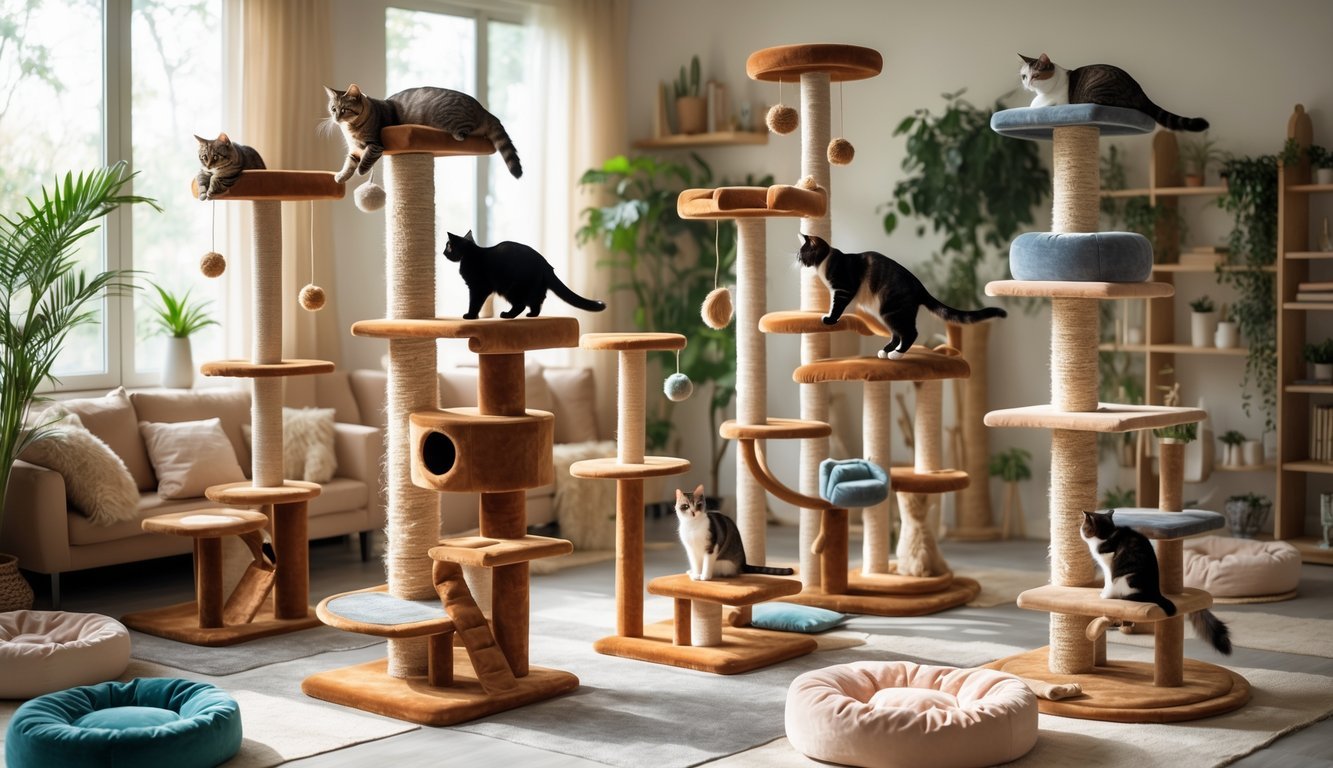
Cats need to climb, scratch, and perch—if you don’t give them a place, they’ll find one (and you might not like their choice).
Cat trees come in all shapes and sizes, from basic posts to tall towers with perches and condos. Pick one that fits your space and your cat’s style.
Sisal or cardboard scratching posts feel great to most cats. Put them where your cat already likes to scratch, like near the couch or by a window.
Mix it up with trees that have hammocks or multiple levels. If you have more than one cat, a few posts around the house help everyone get a turn.
Give your cat these options and they’ll stay busy—and your furniture will thank you.
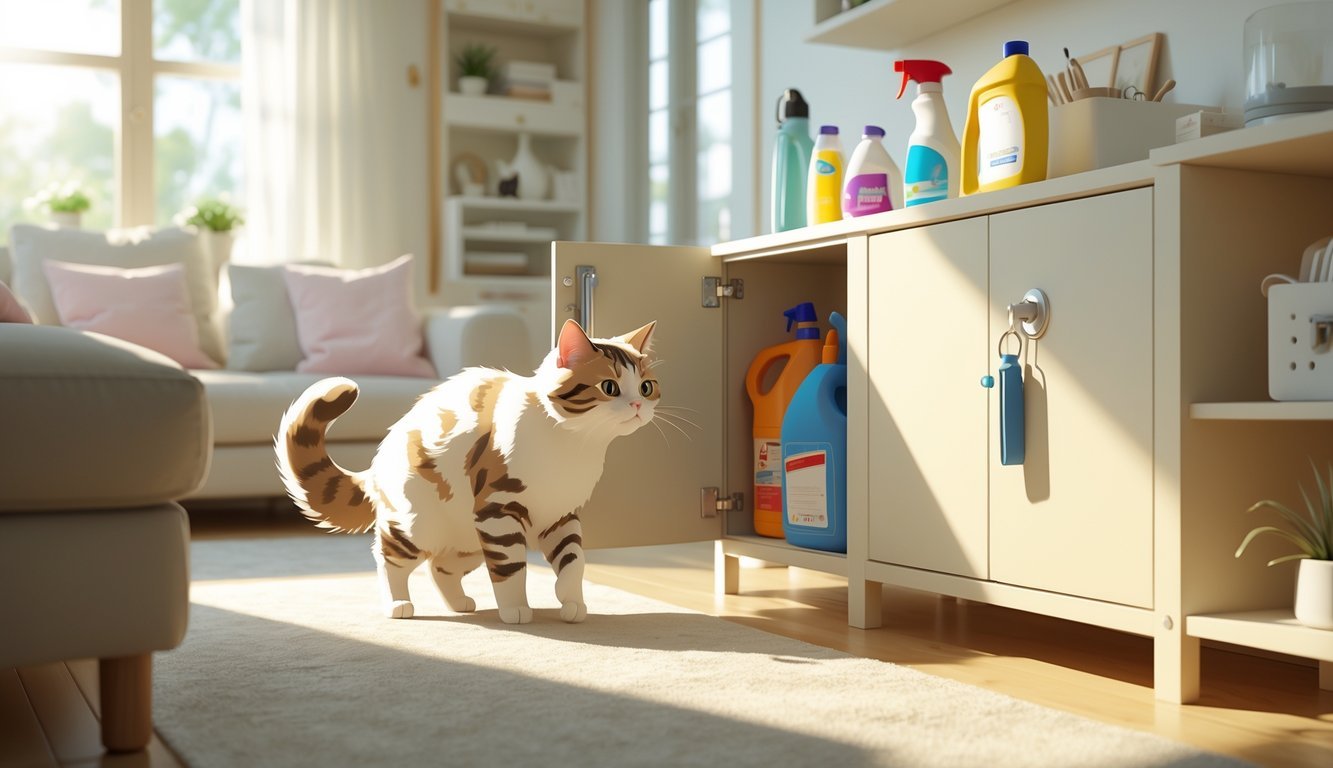
Cats will poke their noses anywhere, even cabinets with dangerous stuff. Closed bottles aren’t always enough—cats can knock them over or chew on lids.
Use childproof locks on cabinets where you keep sprays, detergents, or bleach. It’s a small step that makes a big difference.
Fumes matter too. Store strong cleaners in well-ventilated spots and avoid using them near your cat.
Pet-friendly cleaning products are a good swap if you want to play it extra safe. They’re easier on your cat and still get the job done.
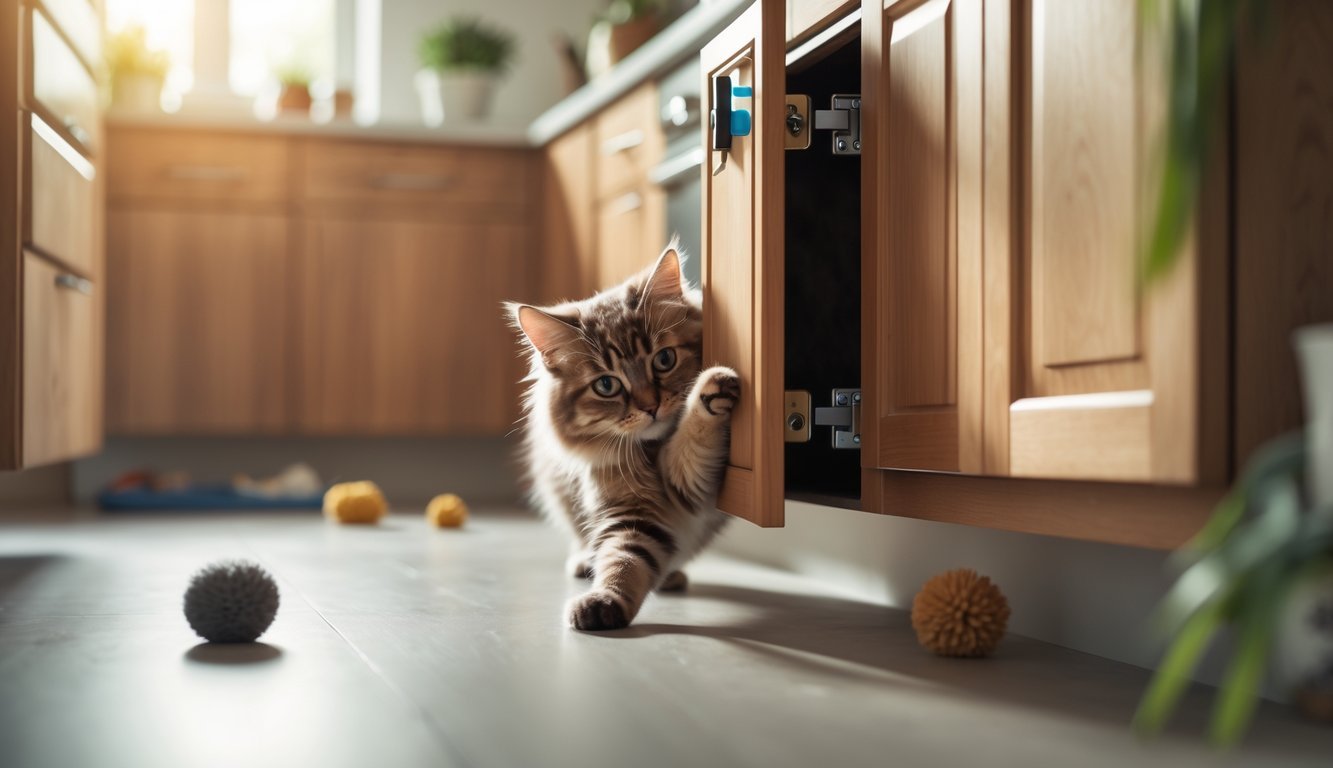
Cats can figure out how to nudge open cabinet doors if you’re not careful. That’s how they get into cleaning supplies, food, or just make a mess.
Cabinet locks come in all styles—child-proof, magnetic, or sliding. They make it tough for cats to open doors, but still easy for you.
Use them in kitchens, bathrooms, or anywhere you keep stuff your cat shouldn’t touch. You’ll avoid finding things knocked over or dragged out.
Most locks are cheap and simple to install. You can grab them online or at the hardware store.
Locking up cabinets gives you peace of mind and keeps your cat out of trouble. Sometimes the easiest fixes make the biggest difference.
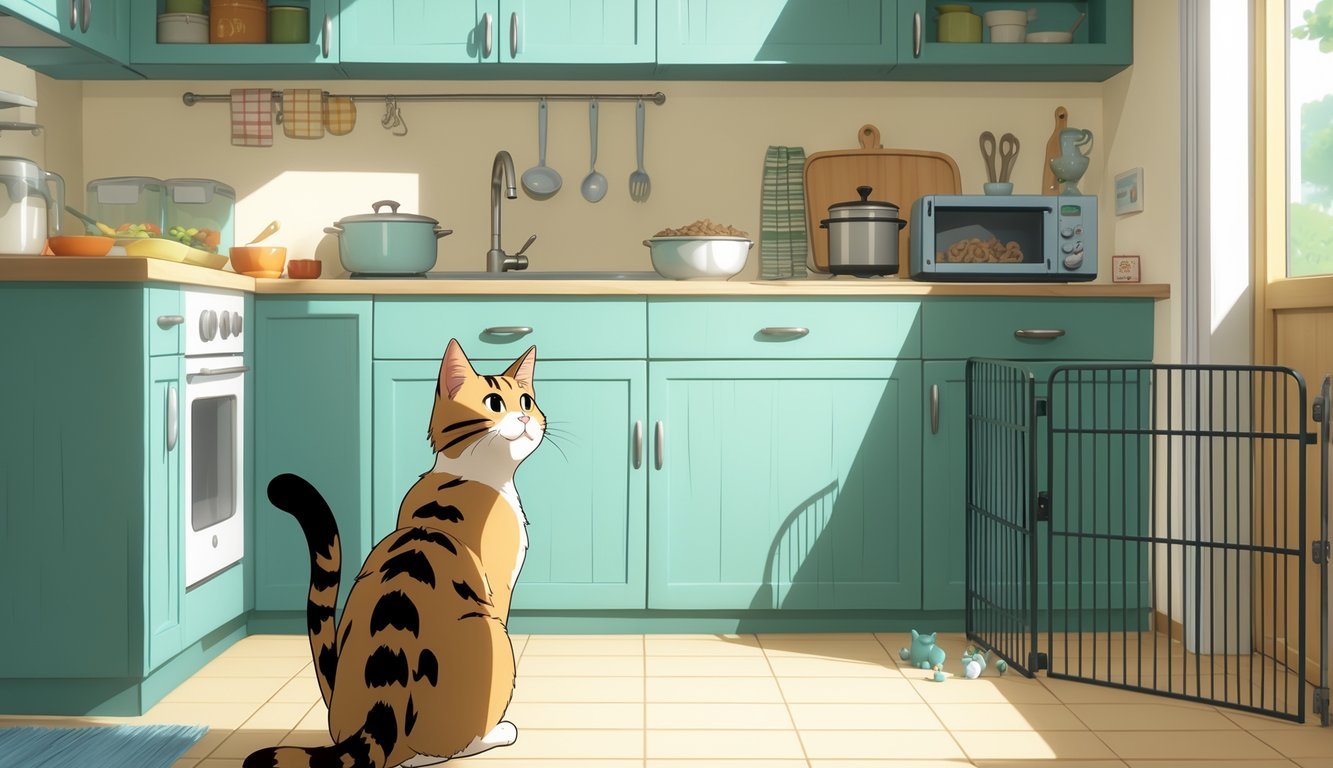
Cats just can’t resist a kitchen counter. They’re curious, fast, and always on the lookout for something interesting. If you leave food out, your cat will probably hop up to check things out or try to sneak a bite.
That habit can quickly turn into begging, which gets harder to stop the longer it goes on.
Some foods you eat without a second thought are actually dangerous for cats. Things like onions, garlic, chocolate, and grapes can make them sick. Even cooked bones or fatty leftovers can cause trouble.
Put food away as soon as you finish cooking or eating. Stash leftovers in sealed containers, and keep counters as clear as you can.
This way, your cat won’t get tempted, and you’ll keep them safer.
If your cat keeps making a beeline for the counter, try distracting them with a toy or treat somewhere else. Eventually, they’ll get the message—counters aren’t their playground.

Your cat’s daily antics mostly come from instincts, not mischief. Scratching, climbing, and exploring help them stay healthy and burn off energy.
These behaviors also help them feel safe in their space.
Scratching isn’t just about sharpening claws. It’s how cats stretch, claim territory, and blow off steam.
When your cat digs their claws in, they leave both visible marks and a scent from their paw glands. That makes the spot feel comfy and familiar.
You’ll probably catch your cat scratching right after a nap. It’s their way of waking up their muscles and joints.
Cats often scratch near busy spots like doors, furniture, or windows. They want to mark the areas everyone uses.
To save your stuff, give your cat scratching posts made from sisal, cardboard, or wood. Put them where your cat already scratches, not in some random corner.
Vertical posts are great for a full-body stretch. Horizontal scratch mats give them a little variety.
Try swapping out or adding new scratching options now and then. If you offer just one post in a room full of tempting furniture, your cat will probably ignore it.
Cats get into trouble when they’re bored, stressed, or just plain nosy. Dangling cords, wobbly shelves, and open cabinets are like invitations to play.
They’re natural hunters, so even a swinging blind cord can set off their pounce reflex.
Big changes at home—like moving furniture, new smells, or a new pet—can make your cat act out. You might see more scratching, climbing, or things knocked to the floor.
That’s just how they cope with change.
Give your cat safe ways to use up energy. Interactive toys, puzzle feeders, and climbing trees help satisfy their curiosity.
Short play sessions every day let your cat burn off steam in a good way.
If your cat gets wild at night, they probably have extra energy to spare. A quick play session before bed can help them wind down—maybe you’ll both get more sleep.

Life gets easier when you pick furniture and surfaces that can handle claws and fur. Keeping up with cleaning helps cut down on odors, dander, and the usual mess that comes with having a cat.
Cats will scratch, climb, and nap just about anywhere. To protect your home, go for materials that stand up to wear and are simple to clean.
Good picks include:
For floors, vinyl, laminate, or tile handle accidents and spills better than carpet. If you love rugs, stick with low-pile ones—they trap less fur and vacuum up fast.
When you shop for scratching posts or cat trees, choose heavy bases and sisal rope covers. These last longer than cardboard and make your cat more likely to scratch where you want.
Keeping your home fresh with a cat around isn’t always easy, but regular cleaning really does help cut down on allergens. Try to focus on small daily habits—trust me, it’s way better than letting everything pile up and then feeling overwhelmed.
Scoop the litter box once or twice a day. Swap out all the litter every week.
Stick a mat under the box to help catch stray litter—makes sweeping way less of a hassle.
When you wipe down surfaces, go for pet-safe cleaners. Cats walk everywhere and then lick their paws, so you don’t want to leave anything harmful behind.
Honestly, a simple mix of vinegar and water gets rid of a lot of messes and doesn’t leave any weird residue.